Last Updated on January 10, 2024 by Greg Gillson
Did you see a brightly-colored red bird, orange bird, or yellow bird in Wisconsin and wonder what is was?
This page is for you!
This article shows you photos and identification of some of the most common birds in Wisconsin based on color.
The list of birds found in Wisconsin includes over 455 species. So, I can’t show you all of them. I’m going to assume that you saw a common bird of this color, but you certainly could have seen something less common, or even rare!
Shape (including the shape of the bill) and size are often more helpful in starting to identify a bird than the color. In fact, most birds in North American can be easily identified with a black-and-white photo!
Many birds are multi-colored, so that it may be hard to pick out a dominant color. Males and females may be colored quite differently. And some color patterns are similar among otherwise dissimilar species.
Nevertheless, I’m going to try to pick out some of the birds that you are most likely to see in backyards or towns. And I’ll show a few others that I get asked about a lot.
The birds with a noticeable amount of red on them in Wisconsin covered in this article are:
- American Robin
- Northern Cardinal
- House Finch
- Rose-breasted Grosbeak
- Ruby-throated Hummingbird
- Common Redpoll
- Scarlet Tanager
The birds with a noticeable amount of orange on them in Wisconsin covered in this article are:
- Barn Swallow
- Baltimore Oriole
- Red-breasted Nuthatch
- American Redstart
- Eastern Towhee
- Brown Thrasher
- Wood Thrush
The birds with a noticeable amount of yellow on them, including lots of yellow and black birds, in Wisconsin covered in this article are:
- American Goldfinch
- Northern Flicker
- Common Yellowthroat
- Cedar Waxwing
- Yellow-rumped Warbler
- Yellow Warbler
- Great Crested Flycatcher
- Nashville Warbler
- Pine Siskin
- Eastern Meadowlark
- Yellow-throated Vireo
- Pine Warbler
Red birds of Wisconsin
Birds get the red, orange, and yellow in their feathers from carotenoids in the fruit, seeds, and plants they eat (source).
These carotenoid colors combine with melanin to form an infinite range of red feathers–pink, rusty, scarlet, violet, red-orange.
The following are red birds that you are most likely to see in Wisconsin.
American Robin
These are familiar lawn birds with red breasts.
 |
| American Robin. Greg Gillson. |
Male American Robins are brownish-gray above with a brick red breast. Females are paler orange below and paler gray above.
They are widespread in open country with scattered deciduous trees, residential areas.
American Robins are year-round residents throughout most of Wisconsin, summer residents only in the far north of Wisconsin.
Northern Cardinal
These are one of the most common backyard birds in the eastern United States. Their bright red color and unique head profile makes them instantly identifiable to most people–whether they are bird watchers or not!

Males of these large seed eaters are bright red with a black face and red crest.
Females replace most of the red with brown, The bill is large and orange.
These birds are found in woodlands, stream edges, residential areas.
Northern Cardinals are year-round residents throughout Wisconsin.
House Finch
When people ask about a bird with a red head at their feeder, it is usually this bird.
 |
| Male House Finch. Greg Gillson. |
Males of this dusty brown striped finch have red limited to the head (specifically the forehead and eyebrow), breast (chest), and rump. The red coloration tends toward orangish, and may rarely be yellowish.
Females are streaked, similar to the males but without red. They lack any strong pattern on the face and head.
Note the small round head and curved upper ridge on the bill.
Some people call these red-headed sparrows. Sparrows and finches are similar, but in general, male finches are brighter than the females and tend to hang out more in trees. Sparrow genders are usually quite similar in coloration and tend to feed mostly on the ground.
These birds are common in residential areas, especially at bird feeders. In the West more widespread in arid regions near water.
House Finches are year-round residents in the central and southwestern Wisconsin.
Rose-breasted Grosbeak
These birds with the red breast and huge pink bill sing beautiful robin-like songs from the tops of trees.
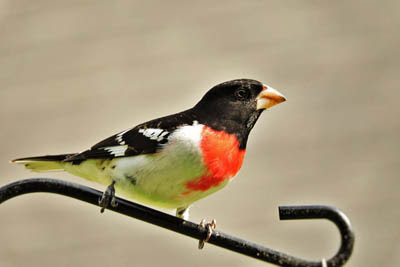 |
| Male Rose-breasted Grosbeak. Susan Killian. Pixabay. |
Males have black hood and upper parts. White under parts. Large white wing patches. Huge pink bill. Inverted bright red triangle on the breast.
Females are brown above, face with broad stripes, white throat. The under parts are buff with many thin brown streaks. Pale bill.
These birds inhabit deciduous and mixed forests. Shade trees in town. Come to feeders.
Rose-breasted Grosbeaks are summer residents throughout Wisconsin.
Ruby-throated Hummingbird
These red-throated birds are the only hummingbird nesting in the eastern United States.

Males are dark green above and on the belly. They have a white upper chest. The throat is ruby-red.
Females are green above, white below, including white throat.
These birds are found in woodland edges, residential yards. Readily come to hummingbird feeders.
Ruby-throated Hummingbirds are summer residents throughout Wisconsin.
Common Redpoll
These frosty pink and red birds are northern relatives of the goldfinches.
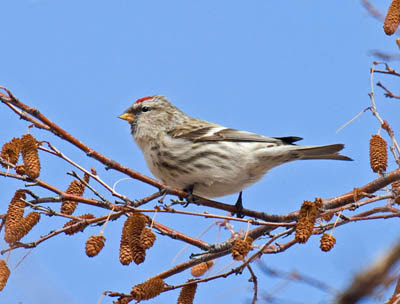 |
| Common Redpoll. Greg Gillson. |
These birds are frosty white in winter with brown striping above and on the sides. Both genders have red caps, black around bill and chin. Adult males have red upper breast. Immatures less red.
These birds are found in weedy fields and alder and birch trees in winter. Come to thistle feeders.
Common Redpolls are winter residents throughout Wisconsin.
Scarlet Tanager
A brilliant red and black bird!
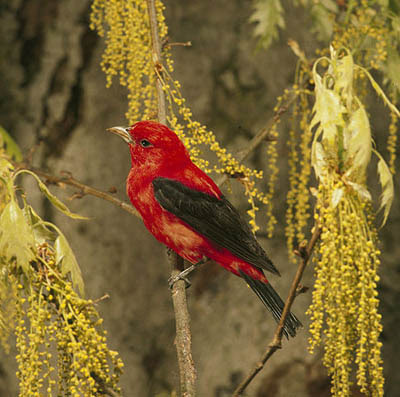 |
| Male Scarlet Tanager. USF&WS. Public Domain. |
Males are unmistakable with brilliant red with black wings and tail.
Females are olive-green above, darker wings and tail, yellower under parts. Pale bill.
These birds live in deciduous woods.
Scarlet Tanagers are summer residents throughout Wisconsin.
Orange birds of Wisconsin
True orange-colored birds are not that common. Many birds that I have here are paler rusty.
The common pattern is an orange body and black or brown wings and tail. Another common pattern is for the orange to be restricted to the under parts.
The following are orange birds that you are most likely to see in Wisconsin.
Barn Swallow
These orange-bellied birds are a familiar sight across North America in summer.
 |
| Barn Swallow. Greg Gillson. |
These birds are purple-blue above with orange under parts and long forked tails. The color of the underparts in winter or on females are often cinnamon or buff-colored, but breeding males can be brighter orange-red.
These birds swoop low over fields and wetlands at lower elevations. They may build their mud nests in rafters on porches, garages, or other out-buildings.
Barn Swallows are summer residents throughout Wisconsin.
Baltimore Oriole
These bright orange and black birds are fairly common breeders in wooded areas in the East.
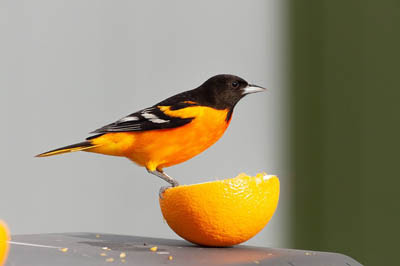 |
| Baltimore Oriole. Michael McGough. Pixabay. |
Males are have a black hood and back. Wings black with white patches. Tail black with orange sides to the base. Bright orange under parts.
Females are similar to males, but more olive above, less black. Immature birds for their first year or more are olive above orangish-yellow on the breast, fading to yellow on the belly. Two white wing bars.
These birds are common in deciduous woods, shade trees.
Baltimore Orioles are summer residents throughout Wisconsin.
Red-breasted Nuthatch
These active little red-breasted birds crawls all around on the trunk and big branches of conifers. They search crevices in the bark for insect food.
 |
| Red-breasted Nuthatch. Greg Gillson. |
These tiny birds have blue-gray backs and a black line through a white face. Some males can have quite bright rusty red under parts. Some females can have quite pale buff-colored under parts. Most birds show an orange-cinnamon breast color.
Found nearly exclusively in conifers. Readily come to feeders.
Red-breasted Nuthatches are year-round residents across northern Wisconsin and winter residents only in southern Wisconsin.
American Redstart
In flight these small warblers flash orange or yellow in the wing and base of the tail.
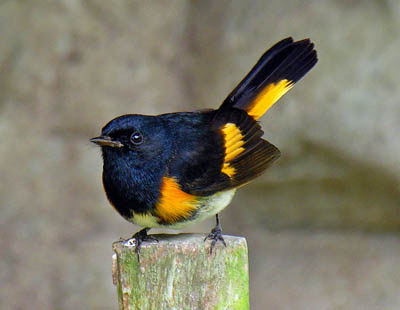 |
| American Redstart. Dennis Jarvis. Flikr. CC BY-SA 2.0 |
Males are black above, white on the belly. They have bright orange patches on side of breast, wings, and base of the tail.
Females are grayer, especially on the head. The orange of males is replaced by yellow on the females.
These birds are found in regenerating woods after a clear cut, and willow tangles along streams.
American Redstarts are summer residents throughout Wisconsin.
Eastern Towhee
These birds with rusty-orange sides like to hide in dense bushes.
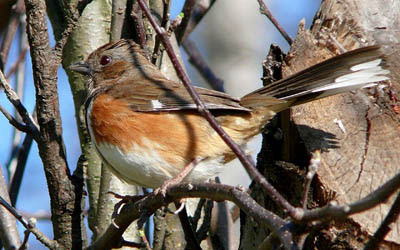 |
| Female Eastern Towhee. Skeeze. Pixabay. |
Males are black above with white wing patch, white tail corners. The sides are rusty. The belly white. Eyes variable: brown, red, orange, white, tending toward whiter southward.
Females are similar, but upper parts brown.
These birds are found in forest understory, dense brush, backyard hedges. Come to feeders.
Eastern Towhees are summer residents throughout Wisconsin.
Brown Thrasher
These are rather large rusty-orange songbirds.
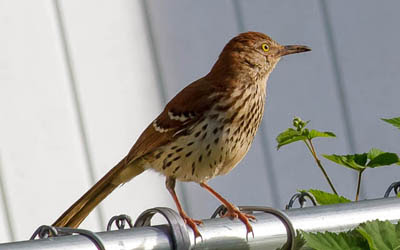 |
| Brown Thrasher. Linda Jones CC0. |
The upper parts of these birds is colored rusty-brown to orange. They show two white wing bars. Under parts are buff with heavy reddish-brown streaking.
These birds live in woodland edges and mature backyard landscaping.
Brown Thrashers are summer residents throughout Wisconsin.
Wood Thrush
These spotted birds with the orange-brown upper parts tend to hide in understory trees and on the forest floor.
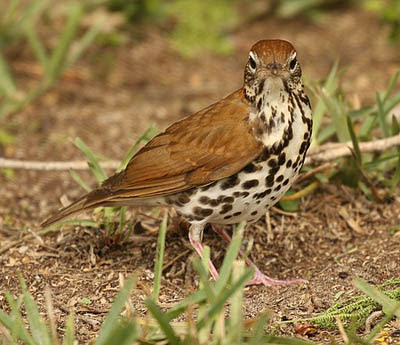 |
| Wood Thrush. Tony Castro. CC BY-SA 4.0 |
These birds are reddish brown on the upper parts, especially rusty orange on the crown and upper back. White eye ring. Large heavy black spots on the under parts.
They live in deciduous and mixed woods. Spend much time on the ground, shuffling through the leaf litter.
Wood Thrushes are summer residents throughout Wisconsin.
Yellow birds of Wisconsin
Yellow is a common bird color! Often it is mixed with black and white plumage in birds.
Many birds with darker upper parts have yellow breast or belly.
The following are yellow birds you are most likely to see in Wisconsin.
American Goldfinch
These small little birds are bright yellow and black.
 |
| American Goldfinch. Greg Gillson. |
Males are bright lemon yellow with black and white wings and tail, black cap. White under tail coverts. Pink bill.
Females are duller yellow below and brownish above. Lack black cap.
Winter birds are pale brown or gray, a touch of yellow on the throat of males.
These are birds of open country, fields with saplings, clear cuts, residential areas. They avoid dense forests, mountains, deserts. They visit feeders.
American Goldfinches are year-round residents throughout Wisconsin.
Northern Flicker
These woodpeckers spend much time eating ants on the ground.
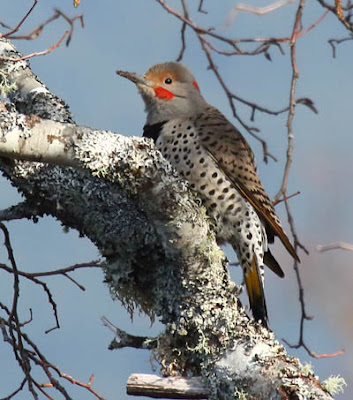 |
| Northern Flicker. Greg Gillson. |
These birds are larger than robins with brown and black barred upper parts. The underparts are pink with round black spots. There is a black crescent across the chest. When they fly away from you they reveal a large white rump.
Western birds have salmon-red under wings and under tail. Those in the East are colored yellow. The male face differs between the two populations–black whisker on the eastern birds, red whisker on western birds. Intergrades from overlap on Great Plains common. These may show male facial characteristics of both populations, or yellow-orange flight feathers.
These birds live in open woods with bare ground for foraging, residential yards.
Northern Flickers are year-round residents throughout Wisconsin.
Common Yellowthroat
These buttery yellow birds are abundant in the marsh vegetation.
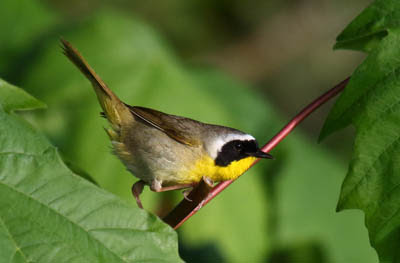 |
| Male Common Yellowthroat. Greg Gillson. |
These skulkers have bright yellow throats and yellow undertail coverts. Males have a black domino mask edged broadly in white, which females lack. Upperparts are dull olive-green.
Immature males in fall show a shadowed black mask.
Found in damp situations and heavy deciduous brambles following clear cuts.
Common Yellowthroats are summer residents throughout Wisconsin.
Cedar Waxwing
These crested birds with yellow band on the end of the tail are often found in flocks. They eat flying insects in summer, fruit and berries the rest of the year.
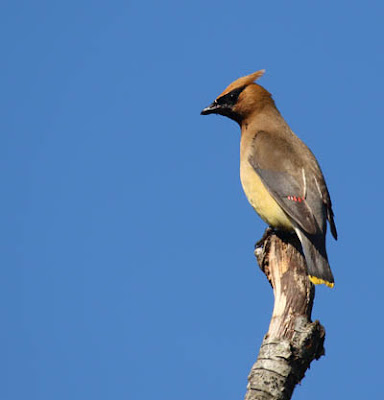 |
| Cedar Waxwing. Greg Gillson. |
These birds are fawn-brown above, with dark gray wings and tail. They have a black mask and wispy crest. The belly is yellow. The wings have waxy red drops on the end of the tertials. The end of the tail has a brilliant yellow tail band.
They are found in open habitats with berries, including juniper woodlands and towns in winter.
Cedar Waxwings are year-round residents throughout Wisconsin.
Yellow-rumped Warbler
These are abundant warblers across North America. Affectionately called “butter butts” by many birders, because of their bright yellow rumps that flash in flight.
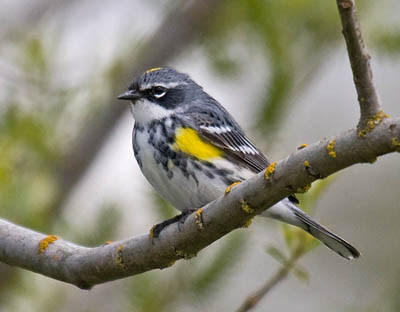 |
| Breeding Yellow-rumped Warbler. Greg Gillson. |
Western form (Audubon’s) with bright yellow throat and yellow rump. Large white wing patch.
Northern and Eastern form (Myrtle) with white throat, yellow rump, and two white wing bars.
Winter birds are dull gray brown, with bright yellow rump. Throat may be cream colored or white. Often difficult to tell the two forms apart in winter.
 |
| Winter Yellow-rumped Warbler. Greg Gillson. |
Breed in mountain or boreal conifers. Widespread in migration. Winter in low river bottoms, open weedy deciduous areas. Rarely come to feeders in winter.
Yellow-rumped Warblers are summer residents only in northern Wisconsin, spring and fall migrants in southern Wisconsin.
Yellow Warbler
The golden yellow sun packed all into one little bird! Appears to be an all-yellow bird.
 |
| Yellow Warbler. Greg Gillson. |
Some populations are bright yellow, some tend toward greenish on upper parts, some more golden. Yellow internal tail corners in flight.
Males with red breast streaking, again, variable by population.
Females somewhat to much paler yellow, some greenish, some whitish. Lack red streaks.
These birds are found in willow thickets on the edge of wetlands and ditches, stream sides in arid regions.
Yellow Warblers are summer residents throughout Wisconsin.
Great Crested Flycatcher
These flycatchers have long tails and big heads with big bill and bright yellow belly.
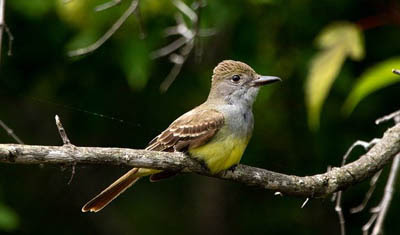 |
| Great Crested Flycatcher. Simard Francois. Pixabay. |
These birds are gray on the face and breast, brownish on rest of upper parts. Bright lemon yellow belly. The under side of the tail and some feathers of the wing are cinnamon colored.
These birds stay in the canopy of open woods.
Great Crested Flycatchers are summer residents throughout Wisconsin.
Nashville Warbler
These birds with the bright yellow underparts do a good job of hiding!
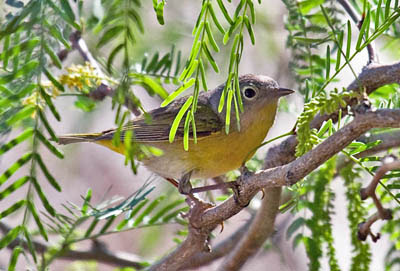 |
| Nashville Warbler. Greg Gillson. |
These birds are gray above. The throat and breast and under tail coverts are bright lemon yellow. The belly is white. They have a complete white eye ring.
Females are just a bit paler than males.
These birds are found in re-growing clear cuts, and understory brush in open woods.
Nashville Warblers are summer residents in northern Wisconsin, spring and fall migrants only in southern Wisconsin.
Pine Siskin
These small brown-streaked birds are relatives of the goldfinches. But you would never know it until they fly and sport yellow wing stripes and tail base. Usually in flocks.
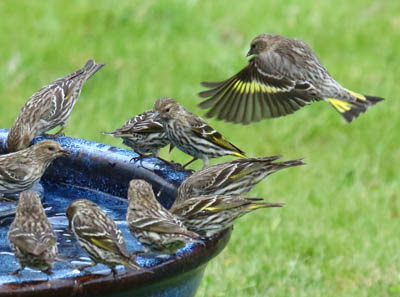 |
| Pine Siskin. Greg Gillson. |
These birds are streaked brown. In flight they have a yellow stripe down the length of the wing. The sides of the base of the tail is also yellow. Some birds are paler, some darker, others brighter yellow, others duller.
These birds are found in summer in northern conifer woods. Irregularly irrupt hundreds of miles southward. Frequent at feeders.
Pine Siskins are year-round residents in northernmost Wisconsin, winter visitors only in most of Wisconsin.
Eastern Meadowlark
These pale brown birds with the brilliant yellow breasts are home on the ground in prairies. They sing from perches on isolated trees, power poles, fence posts.
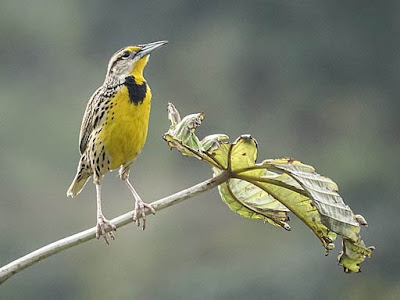 |
|
Eastern Meadowlark
Photo by Mike’s Birds from Riverside, CA, US [CC BY-SA 2.0]
|
The upper parts are streaked black, white, brown, so they blend into the dried grass where they live. The under parts are bright yellow with a black necklace across the chest. Very similar to Western Meadowlark, best told apart by spring song.
These birds live in prairies and extensive pasture lands.
Eastern Meadowlarks are summer residents in most of Wisconsin, year-round residents in southwestern Wisconsin.
Yellow-throated Vireo
Vireos are slow moving small birds that sing throughout the day. These yellow-headed vireos are one of the most colorful of their clan.
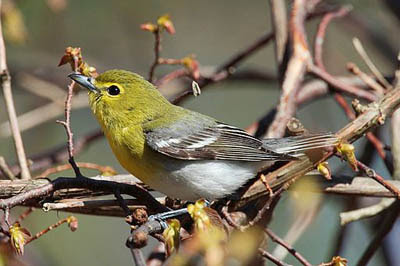 |
| Yellow-throated Vireo. MDF. CC BY-SA 3.0 |
These birds are blue-gray above, white below. Two white wing bars. Their head is olive yellow with yellow spectacles around the eye, and bright yellow throat.
These birds like large tracts of unbroken deciduous or mixed woodlands. Interestingly, however, they are often found on forest edges.
Yellow-throated Vireos are summer residents throughout Wisconsin.
Pine Warbler
This yellow and gray bird is one of the few warblers to visit feeders–and the only one to eat seeds!
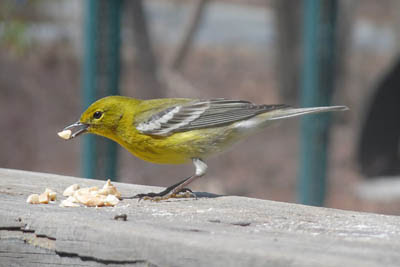 |
| Pine Warbler. Nikolaus Schultz. Pixabay. |
These birds are yellow-green on head, back, and breast. Wings blue-gray with wide white wing bars. Yellow split eye ring.
Strongly associated with pine forests. Usually high in tree tops.
Pine Warblers are summer residents in northern Wisconsin, spring and fall migrants only in southern Wisconsin.
Wrapping Up
Wisconsin boasts a rich and vibrant collection of colorful birds, adding beauty and wonder to its diverse landscapes. Here are some of the most stunning feathered friends you might encounter in the Badger State:
Forest Beauties:
- Scarlet Tanager: Males dazzle with fiery red plumage, black wings and tail, and a black mask. Look for them in deciduous forests during summer.
- Indigo Bunting: These small gems sport vibrant blue bodies and black streaked wings, flitting through coniferous and mixed forests.
- Eastern Wood-Pewee: A splash of yellow amidst the green, these flycatchers have olive-brown backs and bright yellow bellies, often seen in open woodlands.
Meadow Gems:
- Bobolink: Males show off with black bodies, white markings, and a buffy-pink collar, singing their bubbling songs from meadows and hayfields.
- Eastern Bluebird: These sky-blue beauties with orange chests and white bellies bring cheer to open fields and farmlands.
- Yellow Warbler: Tiny flashes of sunshine, these warblers have bright yellow bodies, streaked wings, and a white wing bar, flitting through meadows and shrublands.
Waterfront Wonders:
- Wood Duck: A kaleidoscope of colors, males boast iridescent green heads, red chests, and white necks, while females display elegant brown and buff patterns. You might find them near lakes, ponds, and slow-moving rivers.
- Common Merganser: Striking aquatic birds, males have black-and-white striped heads, green backs, and orange chests, while females are reddish-brown. Look for them on lakes and larger rivers.
- Kingfisher: These vibrant hunters have turquoise backs, orange chests, and a large, shaggy crest. They perch on branches near water, diving for fish with a flash of color.
Frequently Asked Questions
Are there red headed woodpeckers in Wisconsin?
Yes, there are red-headed woodpeckers in Wisconsin! While their populations have declined significantly in recent decades, they still exist in the state and can be encountered in certain areas. Here’s what you need to know:
Presence and Decline:
- Historically common: Red-headed woodpeckers were once widespread throughout Wisconsin, but their numbers have dwindled by around 60-70% since the 1960s.
- Current Status: They are listed as a species of special concern in Wisconsin, indicating their vulnerability but not critical status.
- Remaining populations: Red-headed woodpeckers are primarily found in southern and central Wisconsin, particularly in oak savannas, open woodlands, and agricultural areas with scattered trees.
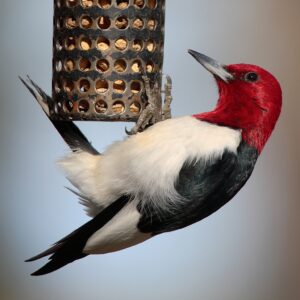
Habitat and Identification:
- Look for them in: Open woodlands, oak savannas, orchards, farms with scattered trees, even parks and nature reserves.
- Key features: Distinctive bright red head and neck, black back and wings, white chest and belly, and a white V-shaped marking on the back. Males have a black stripe from the base of the bill to the nape.
- Size: Medium-sized woodpecker, about 9 inches long with a wingspan of 18-20 inches.
- Behavior: Look for them drumming on trees, excavating holes, or catching insects in flight. Their loud, piercing call helps identify them.
Conservation Efforts:
- Habitat restoration: Efforts are underway to restore oak savannas and other suitable habitats to encourage their return.
- Research and monitoring: Studies are ongoing to understand the reasons for their decline and identify conservation strategies.
Seeing a red-headed woodpecker in Wisconsin is a treat! While their numbers are reduced, their iconic plumage and lively behaviors make them a valuable part of the state’s avifauna. By appreciating their beauty and supporting conservation efforts, we can help ensure these vibrant birds continue to grace the landscapes of Wisconsin for generations to come.
What is the orange breasted bird in Wisconsin?
Several orange-breasted birds can be found in Wisconsin, depending on the time of year and habitat. Here are some possibilities:
Spring and Summer:
- American Robin: The state bird of Wisconsin, with a warm orange breast and gray back. Common in backyards, parks, and open woodlands.
- Eastern Bluebird: Stunning bluebirds with a bright orange chest and white belly. Seen in open fields, farms, and woodlands.
- Scarlet Tanager: Males show off fiery red plumage with a black mask and a hint of orange on the underparts. Look for them in deciduous forests.
- Baltimore Oriole: Males boast a vibrant orange body, black hood, and white wing bars. Frequent orchards, parks, and woodlands.
Fall and Winter:
- Cedar Waxwing: Bohemian beauty with a reddish-orange chest and yellow belly. Found in flocks, often near fruit trees or berry bushes.
- Evening Grosbeak: Large finch with a yellow head and orange chest. May come to feeders in winter, especially if offering sunflower seeds.
Where can I find a Yellow Warbler in Wisconsin?
Finding a Yellow Warbler in Wisconsin is a delightful possibility throughout the warmer months! Keep an eye out for these jewels in your backyard but here are some specific locations where you can also find them:
Spring (May-June):
- Habitat: Look for them in wet areas with deciduous trees and shrubs, particularly willow thickets, alder swamps, and edges of marshes. They also frequent damp woodlands and overgrown fields.
- Locations: Explore nature reserves, wildlife refuges, and state parks with suitable wetland habitats. Publicly accessible wetlands within urban areas can also hold surprises.
Summer (July-August):
- Habitat: As breeding season progresses, Yellow Warblers become more widespread. You might find them in diverse habitats like deciduous forests, open woodlands, parks, backyards, and even gardens with tall shrubs and trees.
- Locations: Check parks, natural areas, and your own backyard if you have suitable trees and shrubs. Keep an eye out for their energetic foraging and nest building in hidden corners.
Fall (September-October):
- Habitat: Yellow Warblers start preparing for migration during fall and prefer areas with abundant food sources. Look for them in shrubby fields, edges of wetlands, and open woodlands where they can gather insects and berries.
- Locations: Similar to spring, wildlife refuges and natural areas with diverse vegetation offer good chances of spotting them. Open fields near wetlands can also be productive.
Related:
See photos and learn about the most common backyard birds in Wisconsin, regardless of color.
See photos and learn what to feed winter birds in Wisconsin.
Learn even more about the Birds at your feeder in Wisconsin.
Here’s a quick tutorial of how I would teach you to identify birds: 7 Steps to Identify Birds!
Birds with red heads in North America.
Yellow-and-black birds in North America.
Little Brown Birds at your Feeder.










